Whether you’re looking for a competitive canicross companion, a deterrent for strangers on your jog, or a partner to get in shape with, there are several dog breeds for runners that might work for you.
My Border Collie is my main marathon training partner. He keeps me company on our 18-mile morning slogs and motivates me during tempo runs. His presence comforts me on dusky jogs and when crossing under that one sketchy bridge on the path (you know the one).
We also compete in skijoring and are training for canicross races!
But how do you go about finding your canine jogging companion? The best dog breeds for runners are a varied bunch, depending on your goals. Let’s break down the best dog breeds for runners.
The 13 Best Dog Breeds for Runners
Not surprisingly, this list is dominated with medium to large dogs bred for endurance. While you absolutely can take your larger or smaller dog running, it’s just not quite what they’re bred for! Here’s our baker’s dozen of the best dog breeds for runners.
1. Vizsla
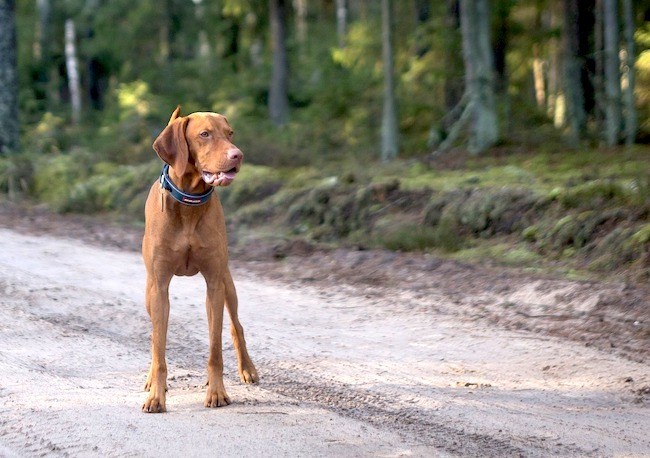
With a handsome, rust-colored coat, the Vizsla is a bird hunting dog. They are total balls of energy that should not be underestimated!
- Best For: Long trail runs, good in the heat, going fast. Excellent for competitive canicross.
- Off-Duty Behavior: Wired. These dogs practically vibrate with energy, and often don’t do well in civilian or city lifestyles. Be prepared for daily exercise, even when you’re sick of running
- Common Health Concerns: Hip dysplasia, blood clotting disorders, epilepsy.
2. Weimaraner

Sleek, silvery fur makes the Weimaraner nearly unmistakable. They’re quite a bit larger than the Pointers and Vizslas, but are similarly leggy and energetic.
- Best For: Long trail runs, fast. Excellent for competitive running or skijoring if you keep them warm.
- Off-Duty Behavior: Energetic, but generally not frenetic. Expect daily exercise.
- Common Health Concerns: Prone to bloat, otherwise generally healthy.
3. Pointer (German Wirehaired or German Shorthaired)
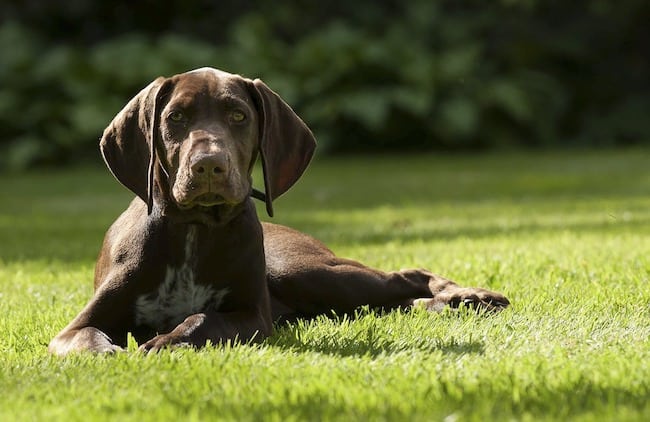
These dogs are go-go-GO! Pointers are the slightly more common cousin of the Vizsla. They often have handsome spotted coats and are gracefully leggy.
- Best For: Fast, hilly trail runs. Wirehaired Pointers have a burr-repellent coat. Both varieties can excel at shorter races.
- Off-Duty Behavior: Similar to the Vizsla, the Pointer often requires a lot of exercise every day. They can be busybodies of sorts, and often need a lot of “work” to do.
- Common Health Concerns: Generally long-lived, may experience some hip dysplasia, hypothyroidism, or bloat.
4. Siberian Husky
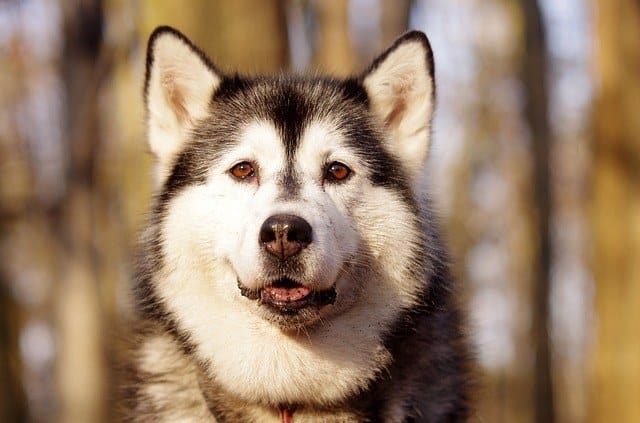
The quintessential running dog, Huskies love to pull and run. They’re not as fast as the upland game dogs above, but they’re endurance freaks. They can’t be shaved and have a plush coat, so look elsewhere if you want a summer running buddy.
- Best For: Long winter runs, pulling sports such as skijoring or mushing.
- Off-Duty Behavior: Huskies are known for howling, digging, and otherwise being a nuisance if under-exercised (and sometimes even when they should be tired). They love chasing bunnies and can be tricky to train, but they are a joy to live with when your personalities mesh.
- Common Health Concerns: Eye issues, hypothyroidism, hip dysplasia.
5. Fox Terrier
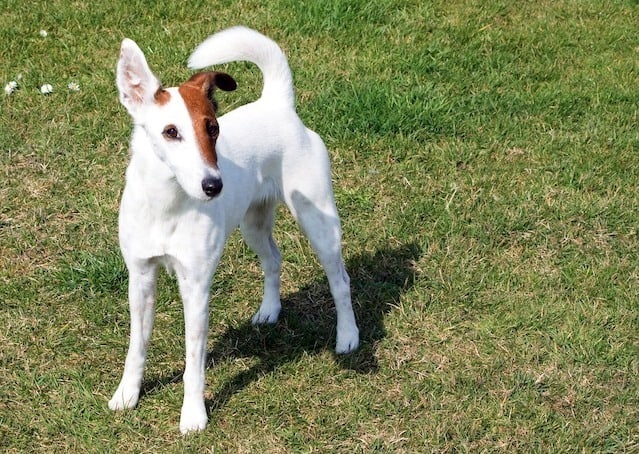
One of the smallest dogs on this list, the Fox Terrier has a nice wiry coat that keeps him cool. This breed has a characteristically cheery yet energetic temperament. They’re not generally good off leash without substantial training, but boy are they fun!
Best For: Regular, shorter runs. Good in the heat.
Off-Duty Behavior: These dogs tend to be spunky and playful, but won’t need a daily run. They are real hunters, so keep them on leash or behind a fence until you’ve done a lot of training!
Common Health Concerns: Generally healthy, no common issues that directly affect running. Most commonly struggle with eye diseases or cataracts.
6. Whippet
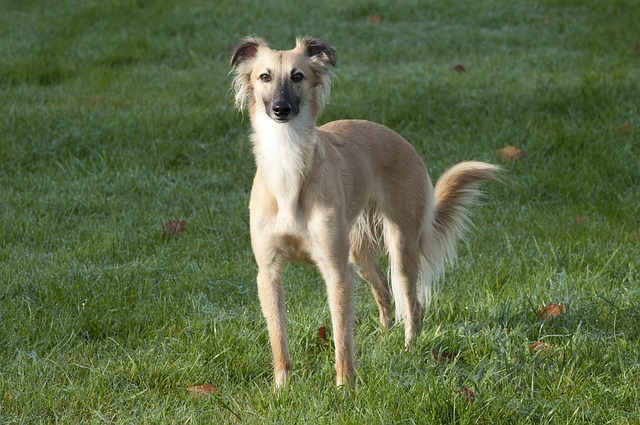
Leggy and lean, whippets are built for speed. In fact, they might seriously outpace many runners (that’s why we didn’t include their cousin the Greyhound). They’re excellent in the heat and generally lounge around at home.
Best For: Fast runs, running in the heat.
Off-Duty Behavior: Whippets are generally pretty easy around the home and tend to be couch potatoes. They are tricky to train for off-leash reliability, since they’re bred to chase fast-retreating objects (such as bunnies or cars).
Common Health Concerns: Allergies and eye issues such as cataracts and lens luxation.
7. Eurohound
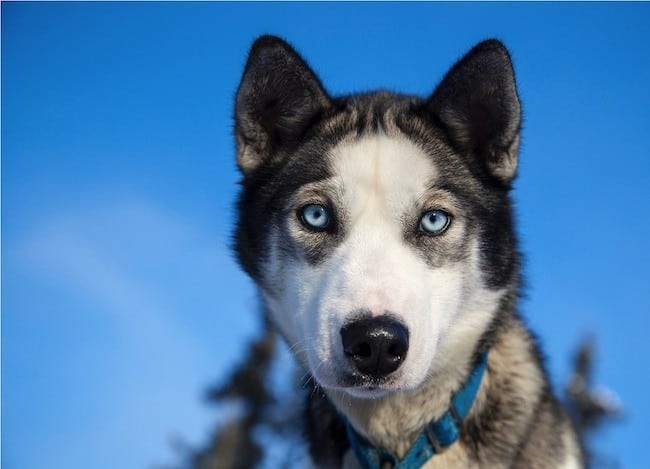
The Eurohound is technically a mixed breed dog. They’re bred for sled racing, canicross, skijoring, and bikejoring. And they’re fast. Generally, a Eurohound is a mixture of a Siberian Husky and a pointing breed (most often the German Shorthaired Pointer). Sprint racers prefer to have 50/50 mixes (fast and light, but gets cold easily), whereas distance racers generally will only have ⅛ Pointer to ⅞ Husky.
- Best For: Competitive running or pulling. Pick the percentage of Husky that suits your climate.
- Off-Duty Behavior: Variable (they are mixed breeds, after all). These dogs are bred for racing and running, so don’t expect a couch potato dog!
- Common Health Concerns: Variable. Bloat, hip dysplasia, and eye issues may occur but they do have some hybrid vitality.
8. Border Collie
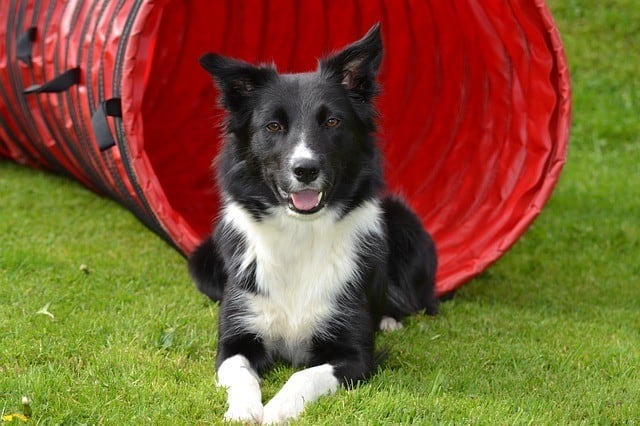
Whip-smart and with an energy level to match, the Border Collie isn’t a good dog for beginners – but they’re often great for runners. With two coat types to pick from and a generally healthy bloodline, Border Collies are great options if you can keep up! Their close relative the Australian Shepherd is another good running buddy, but the Border Collie’s smooth-coated option meant they made the list instead.
- Best For: Daily runs of almost any distance, not generally good at pulling. Pick a smooth-coated Border Collie if you’re in a warmer area.
- Off-Duty Behavior: Variable, but generally Border Collies are very busy. If they’re bored or under-exercised, they can be anxious, clingy, and obsessive. Plan for daily exercise and lots of mental enrichment for these overachievers.
- Common Health Concerns: Generally healthy, but may suffer from hip dysplasia.
9. Labrador Retriever
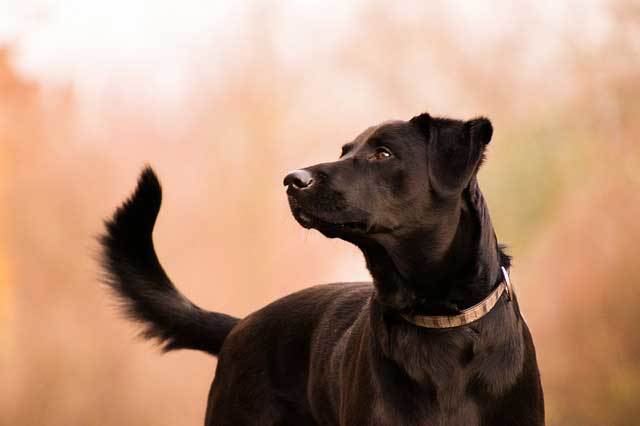
What is the lab not good at? These all-around family dogs can be great jogging partners. Opt for a “field bred” Lab to get more energy, or a “pet line” Lab to get a casual weekend warrior.
- Best For: All-purpose jogging buddy. Depending on the individual, they may need that daily run – or they might not. Generally not a first choice for racing.
- Off-Duty Behavior: Varies. Many labs are excellent family pets that lounge around the home and love playtime. Others, especially those bred for hunting, can be nearly as energetic and needy as a Border Collie!
- Common Health Concerns: Hip dysplasia and cancer are both huge concerns for this breed. Ensure your Lab’s hips are cleared before starting to take him running.
10. Parson Russell Terrier
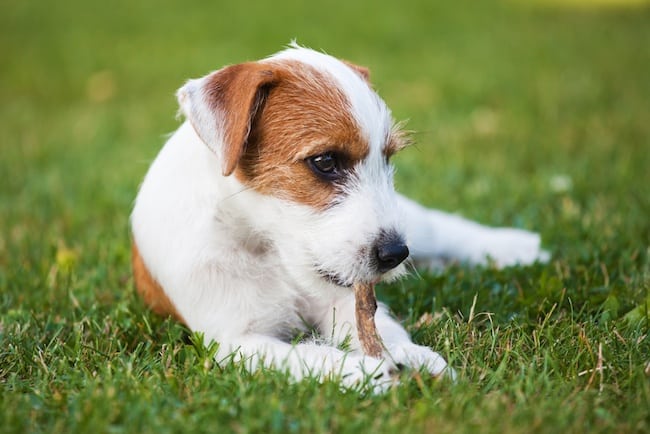
Spunky yet sweet, the Parson Russell Terrier is the slightly more energetic and larger cousin of the Jack Russell Terrier. They’re quick enough to keep up with most runners, yet small enough for city apartments.
- Best For: The urban jogger.
- Off-Duty Behavior: Energetic, but cuddly. Expect “mandatory” playtime most days, but this dog won’t drive you bonkers if you can’t run that day (unlike the Pointers in the list).
- Common Health Concerns: Compulsive behavior (chasing imaginary flies, digging, tail-biting), cancer, and patellar luxation. Check your Parson’s knees before taking him on the trails.
11. Standard Poodle
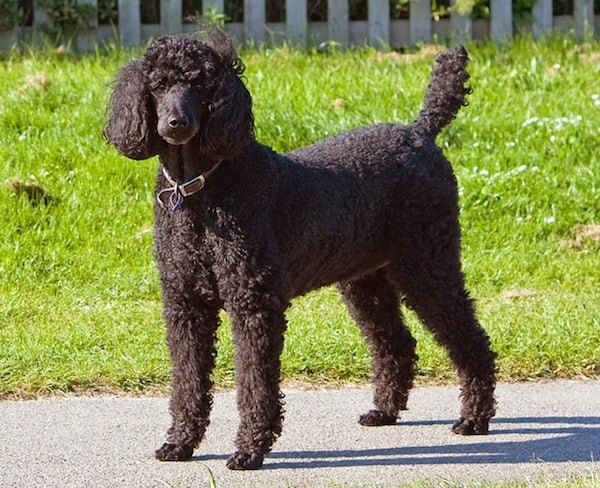
The Poodle defies its aristocratic looks and is a true athlete. Their long legs and shaveable coat make them a great choice for warmer climates – especially if you’d rather skip the frenetic energy of a Vizsla. For shorter, slower runs, you can opt for the Miniature Poodle instead.
- Best For: All-purpose jogging.
- Off-Duty Behavior: Poodles can be clingy, but otherwise are fun to live with. They’re very smart and need a reasonable amount of exercise. Poodles, when properly exercised, can be good urban or suburban pets.
- Common Health Concerns: Poodles may suffer from progressive retinal atrophy, bloat, or epilepsy. Concerning for running, they are also prone to collapsed tracheas.
12. Pit Bull
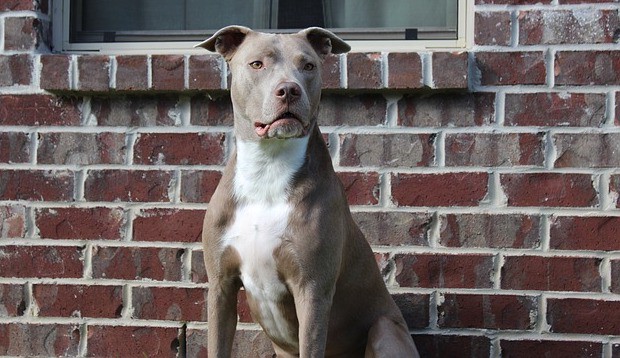
With their wide grins and almost overly muscular bodies, Pit Bulls are an excellent and determined running partner. Pick a longer-nosed Pit Bull (not a short-nosed, boxer-like one) and they’re generally good in the heat (but not very fond of the cold). Pit Bulls are also excellent stranger-repellant, making them a popular choice for female joggers.
Best for: The daily jogger.
Off-Duty Behavior: Pit Bulls can be playful to a fault, so it’s important to teach them to relax and give them adequate mental and physical exercise. They tend to be very sweet with their families and can be quite the snugglers.
Common Health Concerns: Generally healthy, may suffer from hip dysplasia or allergies.
13. Belgian Malinois
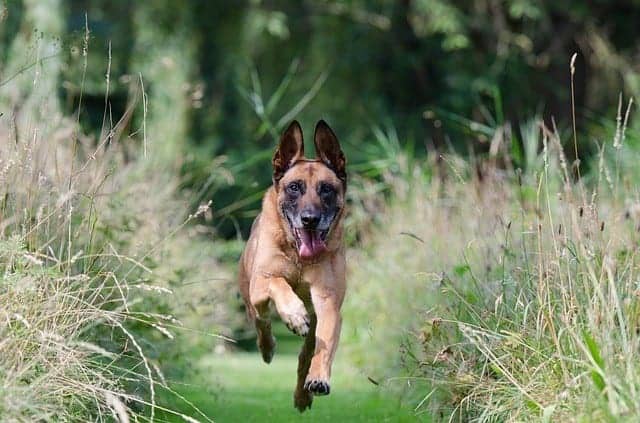
Not for the faint of heart, Belgian Malinois are right up there with the Border Collie on both smarts and energy. With alert ears and an intimidating bark, the Belgian Malinois is a popular choice for personal protection dogs. They also make great running companions when well-trained!
- Best For: Brisk, medium length runs or long and slow runs.
- Off-Duty Behavior: These dogs are not for beginners. They can be quite territorial and may pace and patrol incessantly if not given a different job. “Mals” are excellent dogs for trainers and athletes who will appropriately channel their energy and brains. That said, when they’re adequately cared for, they’re not above a well-earned snooze!
- Common Health Concerns: Belgian Malinois are prone to elbow dysplasia, a serious concern for running. They can also have eye issues such as progressive retinal atrophy and cataracts.
Obviously, there will always be variation within breeds. I’ve met Border Collies that would rather run behind their owners and nip at them — not fun at all! I’ve also met some spunky little Pomeranians who would happily join you for a 3k, provided it’s cool enough outside.
Traits of a Good Jogging Dog
Let me be totally straightforward. The most important thing when finding a canine running partner is not breed. While you’ll certainly have a hard time running with a Tibetan Mastiff or a Pug, it’s probably easier to list breeds that are decidedly bad running companions than the “top XX breeds for runners.”
Rather, a good dog for a runner is a type of dog. It’s a combination of physical and mental characteristics that spans across many breeds. Of course, you can always bring home a cute mixed-breed from the shelter, too!
We’ll list the dog breeds that we think are most likely to check off the boxes, but this is by no means an exhaustive list.
First, let’s look at the qualities or personality traits for a good running companion. When I’m looking for a good dog for running, I look for:
Size. Dogs with ultra-long or super-short legs will have a really hard time keeping pace with you. I don’t care how slow you think you are, you will probably exhaust your Chihuahua in just a few blocks!
Of course, Italian Greyhounds and Jack Russells can still make decent jogging companions for some people. Dogs that average over about 80 pounds generally have joint issues later in life, so it’s not good for extra large and giant dogs to pound the pavement much.
Snout length. Dogs cool themselves by panting, and running is hard work. Dogs with short noses (like Bulldogs, Boxers, and Cane Corsos) are generally not good running companions. In fact, running is flat-out dangerous for many flat-faced dogs. They simply can’t cool themselves or breathe adequately.
Energy and Desire. Even if your dog is physically capable of running with you, he might not want to. This varies some from individual to individual and can be hard to predict in puppyhood.
If your dog would rather not run with you, he’s not a very good motivator or partner! Find a dog that enjoys lots of activity (and hey, if your current dog doesn’t want to run, there are probably plenty of owners on Wag or Rover who would gladly pay you to run with their dogs).
Coat Type. Unless you’re planning on limiting your runs to the coolest parts of the year, long-coated dogs can be a challenge to run with. You can’t shave many double-coated breeds (like Huskies) because it permanently damages their coat and actually makes them less capable of cooling down, so it’s best to steer clear of heavy coats if you want a year-round jogging buddy.
Good Structure. This is, hands-down, the most important part of picking a dog breed for runners. Structure – or how your dog’s skeleton and soft tissue is literally put together – will obviously vary immensely from dog to dog. While you can find well-structured dogs in the shelter, your best bet for excellent structure is going for a good breeder. Dogs with hip, elbow, or back issues should not go running with you. It’s just not good for them! Structure evaluation takes an expert eye at best (consider asking your vet about it) and x-rays or MRIs at the extreme end, but it shouldn’t be ignored!
A good breeder will only breed parent dogs that have good joints (evaluated by OFA or another organization). If you’re looking for a running buddy from a breeder, be sure to ask about joint evaluations. Many good breeders will also check the puppies, to ensure that they have the structure up for the job. If you’re going for a shelter dog, you might be able to ask knowledgeable shelter staff (we has some big structure nerds at Denver Dumb Friends League), but they’re nowhere near as good as a vet or an x-ray!
If you’re on your own trying to evaluate structure, ensure that the dog’s legs look nice and straight both when standing and in motion. You shouldn’t see knees or ankles that turn in or bow out. The spine of the dog shouldn’t sag between the shoulders and hips, but it also shouldn’t be curved high above the belly (that often indicates pain). If the dog trots, the movement should look easy and smooth, not stiff or gimpy.
For the real go-getter, the book Structure in Action is an amazing self-education resource.
Your Goals. Are you looking for a casual jogging buddy for your weekly pub run 5k, or a speed demon for your long-term cross country goals? Would you rather run marathons and train with your dog five days a week, or are you just looking for a dog that needs some extra exercise in hopes of coaxing yourself off the couch?
Don’t bring home a Ferrari (like a Vizsla or Border Collie) if you’re really looking for a Honda Fit (like a Fox Terrier or a Golden). Some dogs are far better suited to speed versus distance, and some dogs are terrible at relaxing when it’s not time to run, work, or play. If you’re not the type for a long workout every day, be sure to pick a dog that’s ok with that.
Be sure to pick a dog that fits your goals and fits your life during the 154 to 167 hours per week that you’re not spending running. Having the perfect running partner is great when you’re exercising, but your dog needs to be a good fit for the rest of your life too!
One last thing to consider within your goals is your safety concerns. Since the death of Mollie Tibbetts, female runners around the world are speaking up about the harassment they face on their jogs. While having any type of dog with you will provide some deterrence against harassers, just as really any dog will keep opportunistic burglars away,
There are times where I wish that my running partner was a scary-looking Belgian Malinois or a block-headed Pit Bull instead of my sleek little Border Collie. Keep fear factor in mind if you’re a female runner who would really like a protector during your run.
Be sure to look at your future dog as an individual living creature, not a product that’s guaranteed to function in a certain way!
Frequently Asked Questions About Running With Your Dog
Even though running is a relatively low-cost sport that doesn’t require much gear, there’s still quite a bit of preparation before running with your dog. Let’s go over some of the basic FAQs of starting to run with your dog.
How old should a dog be to go running?
Dogs shouldn’t go for runs until their growth plates are closed. Growth plate closure depends on breed and individual, but generally is around 18-24 months of age. No matter how much energy your puppy has, the vets say that you should wait until the growth plates close.
What time of day should I run with my dog?
f your dog is fluffy or thick-coated, it’s generally best to avoid the hottest parts of the day. Early-morning runs are probably the best time because they’re coolest (and safer), but dusky runs will keep your dog cool most of the year as well. On the flip side, hardcore winter runners might want to time their runs during afternoon sun to avoid freezing!
What should I carry during my run with my dog?
Any time you leave the house with your pup, bring poop bags. I always bring at least two poop bags on runs (trust me, you’d rather have extra). I tie them to my waist leash. If you’re not running near water and will be out for more than a few miles, a water bottle that your pup can drink from is a good idea too.
Finally, I generally bring citronella spray. I use a hairband to attach this spray to my waist leash (this jiggles less than the clip). This has come in handy a few times when we’re being charged at or chased by unfriendly dogs. I don’t tend to bring treats on my runs unless I’m going off-leash, but your dog and your routine may call for mid-run treats!
What leash and harness should I use for running with my dog?
I personally use the Ruffwear Omnijore setup for my runs because Barley is supposed to pull me in canicross training, where dogs and owners work together as a team. This setup also has hip pockets (for my phone, keys, poop bags, treats, and citronella spray) and a handy water bottle holder. If Barley and I are just going for a leisurely jog, we use his Ruffwear Front Range Harness and a basic hands-free dog leash. You can check out our other top picks for running harnesses here.
Please, don’t run with your dog on a neck collar (especially not a prong, pinch, choke, or other training collar) or head collar. A comfy back-clip harness is a must.
What if my dog pulls?
Start training for canicross! In this sport, your dog helps pull you through a race. If you’ve got the right setup (another plug for the Ruffwear Omnijore, above), your dog pulling is actually a good thing.
If you’d really rather not have your dog pulling you, take the time to work on loose leash walking and gradually increasing speeds. While it’s ideal to teach your dog to loose leash walk, if pulling is really setting you back, an anti-pull harness or dog training harness might be in order as well.
What sort of training does my dog need to go running?
There are several things you should do to prep your dog for serious running. I put together a comprehensive on how to teach your dog to run with you, along with a more advanced guide to running long distance with your dog. Check it out to read all about ensuring your dog is ready, the skill-based training needed, and physical training for your pup.
For example, I taught Barley the cue “let’s go” which means to go faster, “hike” meaning pull harder, “easy” meaning stop pulling, and “hold up” meaning stop” by giving the verbal cue right before following through on the action. In Barley’s case, we never really had to use treats (or corrections).
You might have better luck teaching the necessary cues using treats during walks, then putting it into use on runs when your dog is already good at the cues.
***
Did we skip over your all-time favorite running buddy? Let us know! We love to hear about your favorite canine companions.

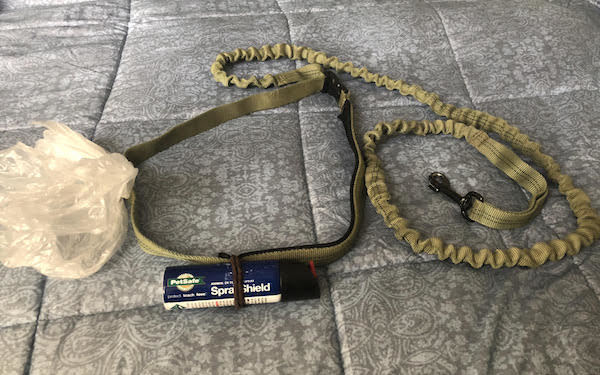
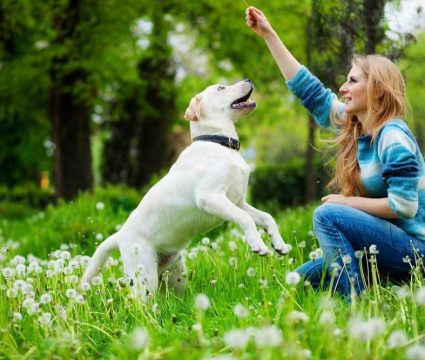
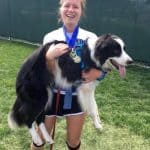


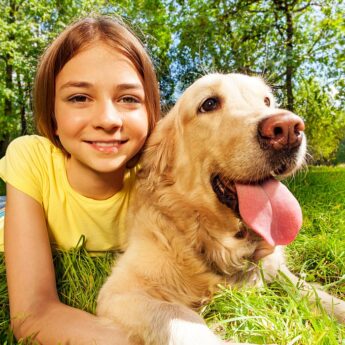
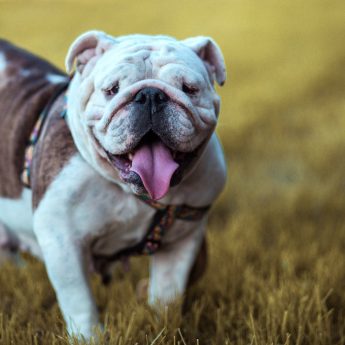
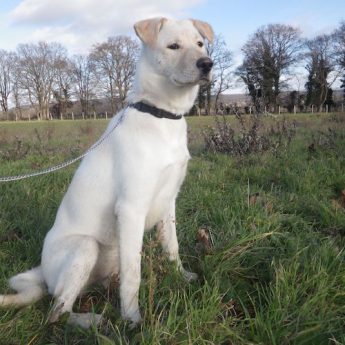
4 Comments
April 20, 2022
Queensland Heelers/Australian Cattle Dogs are also great and highly desirable Canicross companions!
April 21, 2022
They sure are, Jane!
July 13, 2020
Rhodesian Ridgebacks aren’t on this list. I call this list bullshit clickbait.
July 13, 2020
That’s pretty harsh, Mark.
Ridgebacks certainly make great running companions, but we can’t list every breed that would work well for joggers.
Sorry you didn’t see your favorite breed on the list, but this is in no way, shape, or form “clickbait.”
Thanks for reading!